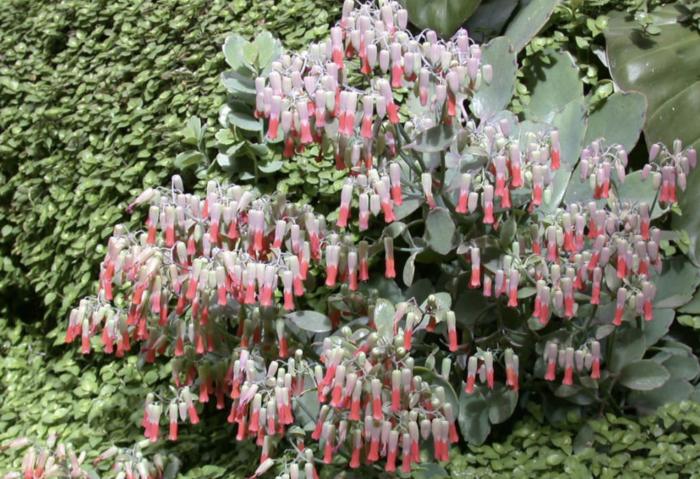Kalanchoe laxiflora
Milky Widows Thrill

Description
Kalanchoe laxiflora typically will not reach a height any taller than around 20 inches due to them being a smaller succulent species. The plant features light green leaves, except for said leaves turning more gray or white, with reddish tips. Little orange flowers can appear blooming off the leaves’ tips during the blooming season. Kalanchoe laxiflora succulents can be planted indoors or outdoors, as long as the temperatures remain safe. With that being said, a Kalanchoe laxiflora is relatively easy to care for and will rarely need attention. Kalanchoe Laxiflora succulents do work better with a specific type of soil; however, there are two ways an owner can do so. A thicker soil, such as a cacti-based soil, or coarse sand, moss, and perlite mixture will suffice. Regardless of which mixture, make sure it is well-draining soil to reduce the chances of overwatering, leading to further complications. Consistent blooming happens during the springtime when temperatures are starting to get warmer. During this time, owners will notice those orange flowers beginning to bloom right before the plant goes dormant during the summer months. Kalanchoe laxiflora requires bright sunlight conditions, whether indoors or outdoors. If your succulent is indoors, it should be placed near a well-lit window where it will receive the necessarily needed hours of sunlight daily. If the sun seems to be hitting the succulent with hot rays, move the succulent away from the window for a few hours, or hang a sheer curtain for safety precautions. These succulents flourish greatly when surrounded by warm temperatures. Specifically, temperatures ranging from 61 degrees Fahrenheit to 80 degrees Fahrenheit are vital for these succulents. Thus, temperatures above 80 degrees Fahrenheit can potentially scorch the plant’s leaves, while temperatures below 61 degrees Fahrenheit can freeze the plant. This species of succulents do not necessarily require fertilizing, as much as they appreciate it from time to time as a little boost. If you fertilize your Kalanchoe Laxiflora, it is best to use a liquid 20-20-20 mixture. This means the fertilizer possesses 20% each of potassium, nitrogen, and phosphorus.
Plant Type
Succulent
Height Range
1-3'
Width Range
Flower Color
Orange
Flower Season
Spring
Leaf Color
Light Green
Bark Color
n/a
Fruit Color
n/a
Fruit Season
n/a
Sun
Half, Shade
Water
Low
Growth Rate
Slow
Soil Type
Sandy, Loam, Rocky
Soil Condition
Poor, Well-drained, Dry
Soil pH
Neutral
Adverse Factors
n/a
Design Styles
Meadow, Mediterranean, Ranch
Accenting Features
Specimen, Unusual Foliage
Seasonal Interest
Spring
Location Uses
Entry, Indoor, Patio, Raised Planter, Walkways, With Rocks
Special Uses
Container, Small Spaces, Hanging Baskets
Attracts Wildlife
n/a
Water Saving Tip:
Change spray sprinklers to low-flow bubbler or drip systems.
Shrubs and trees are ideal candidates for this type of irrigation because the water is applied directly to the root zones.